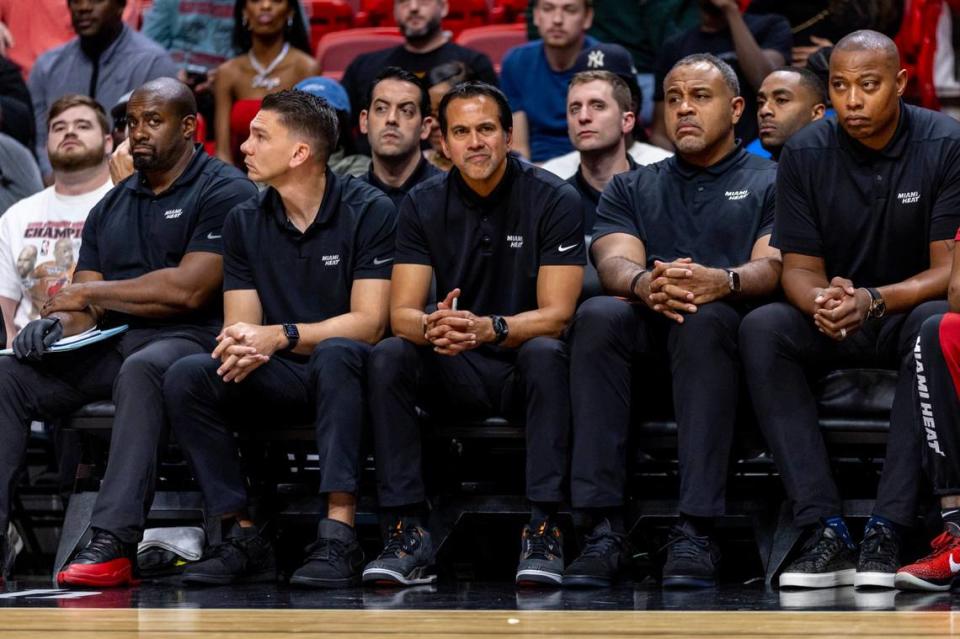Can Heat solve its offensive issues this offseason? Spoelstra: ‘That’s what I will get to work on’

The Miami Heat’s defense was again a top-10 unit this season. The problem is the Heat’s offense was again a bottom-10 unit.
While finishing with a top-10 defensive rating for the eighth time in the last nine regular seasons, the Heat closed this regular season with a bottom-10 offensive rating for the second straight season. The Heat ended this regular season with the league’s 21st-ranked offensive rating after posting the league’s 25th-ranked offensive rating last season among the 30 NBA teams.
This offseason, the Heat’s coaching staff will work to find strategic solutions for those offensive issues and the Heat’s front office will work to address its offensive shortcoming through the draft, free agency and/or trades. The two-round draft begins on June 26 and free agent negotiations around the NBA open on June 30.
“That’s what I will get to work on, the coaching staff will get together quite a bit to try to put together a more productive offensive plan,” Heat coach Erik Spoelstra said in early May just days after the team’s season ended in the first round of the playoffs at the hands of this year’s Eastern Conference champion Boston Celtics.
While Spoelstra made clear that he will take “a deep dive” into the Heat’s offensive struggles, he pointed out that injury issues didn’t help.
“We had basically three primary offensive philosophies this season and a lot last season based on who was available,” Spoelstra said. “So all things considered, I thought we were making strides in any one of those areas. But the consistency became a challenge to overcome. And the styles of play were different based on who was available. So I don’t want to make excuses for who was available and who was not, but we also have to look at what’s real and what’s not real.”
The Heat’s injury problem this season was very real.
With the Heat among the most injured teams in the league this season, it set a franchise record with 35 different starting lineups used this regular season. In addition, injuries limited the Heat’s leading trio of Bam Adebayo, Jimmy Butler and Tyler Herro to just 27 games together this regular season.
In this year’s playoffs, the Heat’s trio of Adebayo, Butler and Herro did not play a second together. Butler missed the entirety of Miami’s short-lived five-game playoff run this season because of a sprained MCL.
“I think the intention is there and I think that the personnel is there, truthfully,” Heat three-point shooting forward Duncan Robinson said when asked to diagnose the Heat’s offensive struggles. “I think a big part of it is continuity, establishing a level of rhythm. So much of offense is — you can only run so many sets — it’s got to be just sort of basketball acumen and intelligence that you grow within a group. And you got to have some level of continuity. This year, we lacked that. We had different stretches of the season where we were really playing different ways on offense.
“It’s not anyone’s fault. It’s not the coaches or us, whatever. Obviously, it starts with us players. We got to figure that out. But I do think we have all the pieces and tools this year and hopefully in future years to be a good offense.”
Along with simply not having its best players available for enough games, what else was behind the Heat’s inefficient offense this season?
The Heat’s three-point shooting wasn’t elite, but it also wasn’t bad enough to sink the unit. Miami closed the regular season with the NBA’s 12th-best team three-point percentage at 37 percent.
Turnovers and poor free-throw shooting weren’t problems for the Heat either.
Instead, among the biggest issues were the Heat’s inability to generate enough shots at the rim (one of the most efficient shots in the sport) and the Heat’s struggles to convert on the shots at the rim that it did create.
The Heat attempted 28.5 percent of its field-goal attempts from around the rim this season (third-fewest in the NBA), according to Cleaning the Glass. And the Heat shot just 63.4 percent from within the restricted area this season (seventh-worst in the NBA), according to NBA tracking stats.
Among the eight teams in the league who generated fewer than 25 shots from within the restricted area per game this season, the Heat ended the regular season with the worst shooting percentage from that area of the court.
“It’s tough because we had a lot of moving pieces,” said Heat forward Caleb Martin, who is expected to become an unrestricted free agent this summer despite holding a $7.1 million player option in his contract for next season. “I’m not going to be one to make excuses on who’s playing or who’s not. Whatever it is, ultimately we’re out there, we’re playing, we have enough to win and we have to make enough plays and enough shots in order for us to advance. So we just missed opportunities, missed shots.”
After finishing the last two regular seasons as a bottom-10 offense, Spoelstra knows the Heat needs to be better on that end of the court because a top-10 defense can only get you so far.
“We’ll have to figure out what makes the most sense next season,” Spoelstra said.

 Yahoo Sports
Yahoo Sports 
